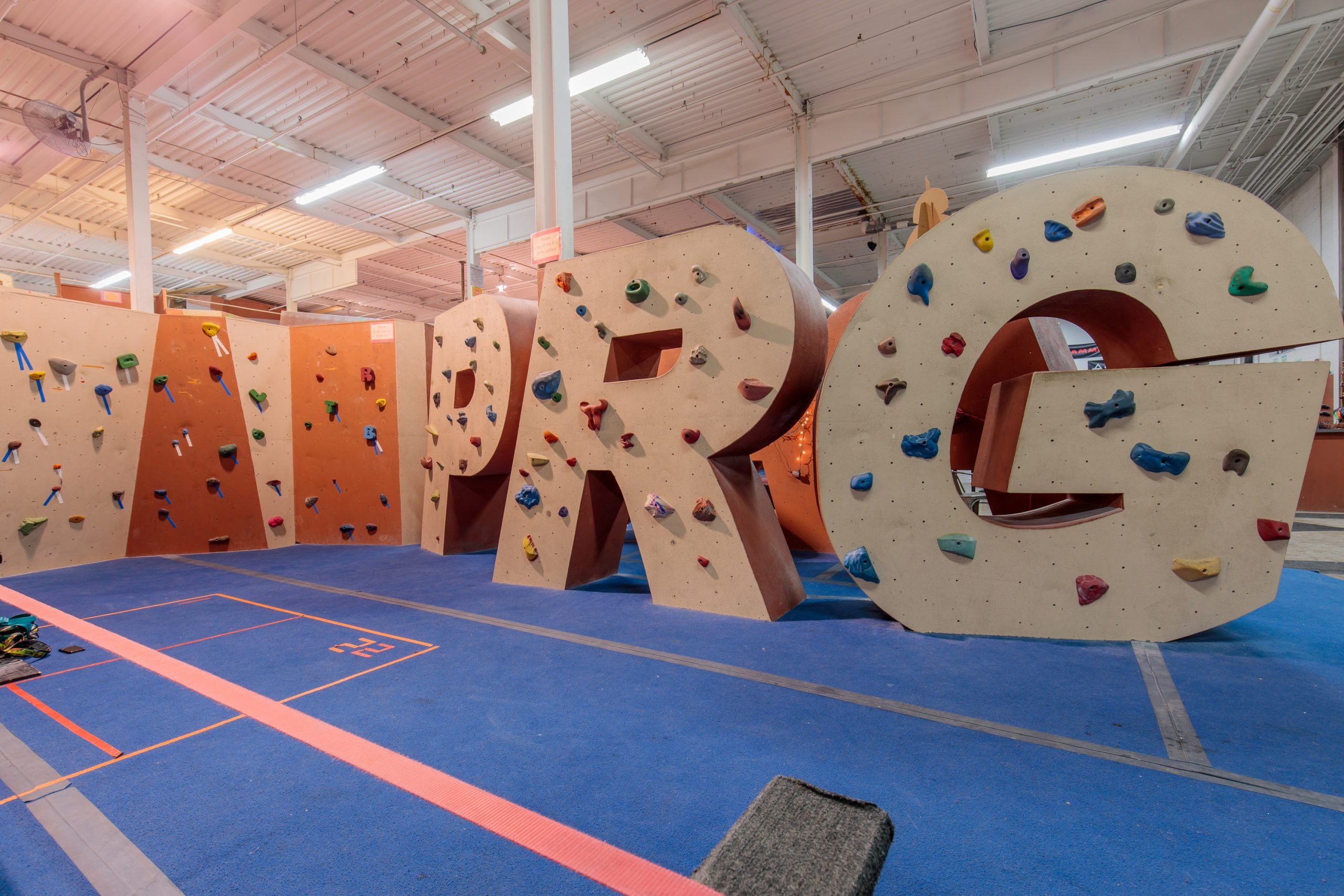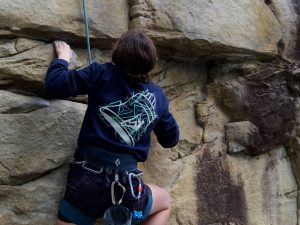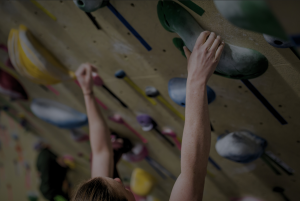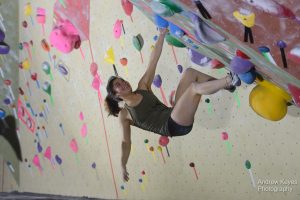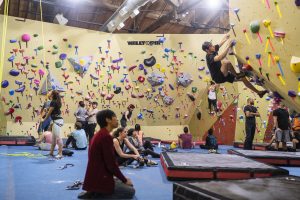Climbing, like many sports, is full of its jargon. Flash? Crimp? Slab? Sometimes you just need a simple explanation especially if you’re a beginner climber or even a long-time member of your local gym. Here is our comprehensive, though not exhaustive glossary of climbing terms. The more you know, the more you know. Kinda like beta for a climb.
Beta – Beta in climbing refers to information about a specific climb or route. This can include the best sequencing or where to find good hand or foot holds. Climbers often share beta to help with difficult moves.
Crux – In climbing, the “crux” is the toughest part of a route, where the hardest moves and challenges are concentrated.
Forms of Climbing
Bouldering – Bouldering is a form of free climbing where ropes are not used for protection. Climbs are usually 15 feet high or less. Typically, some form of padding is used for protection, though this is not necessary.
Top-roping– Top roping is a form of free climbing where the safety system is anchored above the climber’s head. This is opposed to lead climbing where the anchors for the rope are placed as the climber moves up the wall and are, therefore, in general, below the climber.
Lead climbing– Lead climbing involves climbing a route with a rope trailing behind you and placing gear for protection as you go. Lead climbing is typified by the fact that when you fall, you will typically fall at least twice the distance that you are above your last protection piece. Free climbs may be led.
Free climbing– Climbing any rock or artificial wall using gear–pitons, bolts, cams, etc.–only for safety protection. In other words, only using the features of the rock to create upward progress.
Sport climbing– Lead climbing on a route that has fixed protection. For example, bolts or pitons are pre-placed into the rock. Climbers only have to clip into these while climbing instead of placing gear.
Traditional climbing– Lead climbing on a route that has minimal or no fixed protection–bolts, pitons, etc. Climbers bring their own protection gear (cams, nuts, hexes, etc.), to be placed while climbing. They are removed by another person who follows the route on top-rope.
Free-soloing– Free Soloing is a form of free climbing where climbers do not use ropes, gear, pads, or any other form of safety equipment to climb a route (think Alex Honnold). Free soloing differs from bouldering in that the climbs are typically long enough that a fall will likely result in death. Free soloing is often confused with free climbing by non-climbers.
Sends
Send– A send is getting from the bottom to the top of a wall without a fall. Listed below are different types of sends: red-point, onsight, flash, and pink-point.
Red-point– Sending a route on any try after your first. This is the most common form of send. Technically this term applies to lead climbing (i.e. you must place all protection, or hang all quickdraws), but it has been appropriated over the years by top-roping as well.
Onsight- Sending a route on your first try, without any prior knowledge of the route. This includes verbal information (beta) or visual information, such as watching someone else climb the route or problem.
Flash– Sending a route on your first try, with any prior knowledge of the route–verbal, or visual. If you watch someone climb a route, then send it, that’s a flash, not an onsight.
Pink-point (lead only)– Sending a route on any try after your first, with protection already in place, or all quickdraws already hung.
Safety Terms
Belay– Belay is the term for holding the rope for a climber. Typically, a belayer will use a belay device to aid them in holding a fall, but this is not strictly necessary as it is possible to use one’s body as a belay device (e.g. a hip belay).
Slack– A request for the belayer to feed slack into the system. In other words, to reduce the tension in the rope.
Take– A request for the belayer to remove slack from the system so that a climber may sit back on the rope under tension. Typically used before a fall or before a climber is lowered.
Up-Rope– A request for the belayer to remove slack from the system. This differs from the command ‘take‘ in that typically ‘up rope’ is not a request to put the climber under tension, just to remove excess slack.
Quickdraws– Two carabiners placed on opposite ends of a piece of webbing (called a sling or dogbone). This is used to clip to hangers on sport routes (one carabiner for the hanger, one for the rope).
Gear– The generic term for the equipment used to lead traditional or aid routes. Also referred to as protection.
Holds
Jug– A large, easy-to-hold handhold.
Sloper– A handhold that is less than horizontal.
Crimp– A hold type that is generally smaller than two pads. Also refers to the method of gripping a hold.
Pinch– A hold which generally requires, well, a pinch.
Gaston– A hold oriented at an angle so that it must be loaded with a climber’s thumb pointing down.
Pocket– A hold into which a climber may insert 1 or more fingers. They typically look like a hole.
Undercling– A hold oriented so that it must be loaded with an upward pull.
Wall Features
Arete– A climbing feature where two faces meet at an exterior angle. For example, where the outside walls of a square building meet. Angles may vary, but in climbing an arete is typically between 5 and 120 degrees in their angles. Wider aretes (greater than 90 degrees) are often referred to as blunt aretes. Also called outside corners.
Inside Corner– A climbing feature where two faces meet at an interior angle. For example, the corner inside your living room is a 90-degree inside corner. Angles may vary, but, in climbing, inside corners are typically between 30 and 120 degrees in their angles. Also called dihedrals.
Roof– A severely overhanging face. There is no hard and fast rule, but a steep face typically becomes a roof when the angle gets to about 60 degrees past the vertical. Horizontal roofs are generally close to or exactly parallel to the ground.
Slab- A face that is less than vertical. Historically, slabs were generally at least 10 degrees less than vertical (steeper slabs, though still less than vertical were considered steep face). But the modern advent of sport climbing, and gym climbing, have removed this distinction, calling all less than vertical faces slab.
Techniques
Flagging– Placing one leg out straight in order to balance your weight onto the other foot.
Dynamic Movement– A form of climbing movement in which a climber uses their momentum to move up the wall, similar to jumping for a hold.
Deadpoint– A form of dynamic climbing where at least one foot remains on a hold throughout the move.
Dyno– A more extreme deadpoint, where typically your feet do not stay on the footholds.
Double-Dyno– A dyno where the climber goes two-handed to match the finish hold, rather than with one hand or the other.
Grading Systems
Yosemite Decimal System– The standard grading scale in the US for free climbing routes. Invented, as the name suggests, to grade routes in the Yosemite Valley, CA.
The system follows a scale that begins at 5.0 (the easiest climbing, sometimes referred to as “a ladder”) and 5.15c (currently the hardest confirmed free climb in the world).
The “5” prefix for climbs comes from an antiquated method of grading hikes, and is a reference to the “class” of the hike: Class 1 hikes are generally flat, Class 2 are steep hikes, etc. Class 5 “hikes” are considered to be sheer cliffs where a fall would likely result in serious injury or death, and therefore require ropes and other safety equipment to be made safe.
The Verm Scale– The standard grading scale in the US for boulder problems. Invented, as the name suggests, by a guy named Verm–well, nicknamed Verm, his real name is John Sherman.
This system was originally intended to be used only in Hueco Tanks, and only by the handful of male boulderers who frequented the area. It has since been co-opted by other climbing areas, both indoors and out. The system begins at VB and runs currently up to V16. The V-scale uses “-” and “+” to indicate easier or harder routes in the grade (e.g. V0- or V6+).
Glossary of Climbing Terms
Now that you have a basic understanding of climbing with our glossary of climbing terms, go out there and flash that bouldering route using those slopers. Or at the very least, sound cool saying it.
All material is reprinted with the permission of the author. Copyright 2022 David H. Rowland. All rights reserved.


